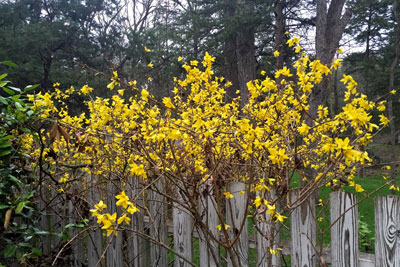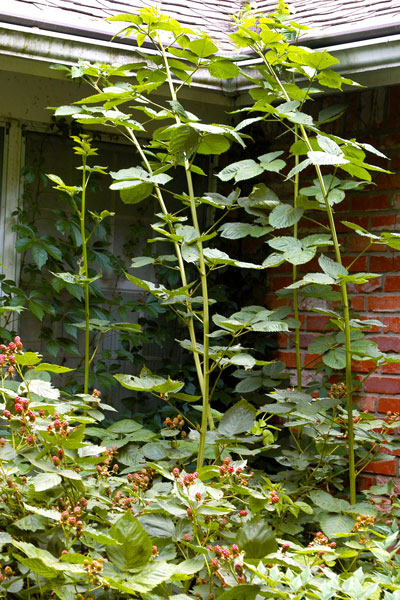Grab Bag: March 10, 2016
Here are three mini-topics that deserve a moment in the spotlight. Each of them this time has to do with some type of timely pruning.
Reshaping Spring-Flowering Shrubs, Vines

Forsythia, like other spring-flowering shrubs and vines, should be pruned immediately after flowers have all fallen.
The proper time to prune shrubs and vines that flower in spring is immediately after they finish blooming. Yep – that time is here now (or soon will be) in South Texas, with North Texas falling in line a week or two later. It will be a different time for each type of shrub that you’re growing. Flowering quince, for example, finishes blooming a month before forsythias and azaleas will.
There is a short window of several days after that spring bloom in which you need to do that pruning. The flowers are falling, and the new shoots haven’t started their burst of new growth.
• Use lopping shears and hand shears. Hedge trimmers aren’t selective enough.
• Remove one branch at a time, preferably making each cut flush with the remaining stem.
• Start with the stem that most dramatically stretches outside the plant’s normal growth form. It might be a branch that shot out 18 inches above the rest of the leaf canopy, or it could be one that drags the ground. Wherever it is, remove it.
• Next, remove the second most offensive shoot, and then continue on with the reshaping until the plant has been returned to its tidy and natural good looks.
• Apply an all-nitrogen fertilizer to promote good stem growth this spring and summer, so you’ll have maximum flowers next spring.
Harvesting Asparagus

Once the year’s harvest of asparagus spears has been completed, plants must be allowed to produce “fronds” of leaves to store food for next year’s harvest.
When you harvest asparagus spears, you’re actually cutting the plant’s entire stem. That harvest continues from very early spring and lasts six or seven weeks, and then you must shut it all down. Let the subsequent spears develop into leafy stems the rest of the growing season. They’re responsible for storing up energy for next year’s harvest.
Was this year a great year for asparagus harvests in Texas? I suspect not, and that would be because of the extremely mild winter. The biggest and best asparagus spears are produced in colder climates.
Pruning and Not Pruning Blackberries

There is an art and science to correct pruning of blackberries. Here you see prior year’s fruit-bearing canes along with current year’s extremely vigorous shoots that should have been kept shorter all along.
OK. Wipe out your eyes. Get ‘em focused and ready. This information is short, but it can be confusing.
• Blackberries produce fruit in 2016 on canes the plants grew in 2015. So don’t prune them at all.
• Once those canes that grew in 2015 are through bearing fruit, they will never, ever bear fruit again.
• As soon as the canes have finished all of this year’s production, cut those 2015 canes completely to the ground.
• All the while, new 2016 canes will be shooting up vigorously. They may be growing even taller than the fruit-bearing canes from the prior summer.
• It’s probably a good idea to tip-prune (by pinching or with sharp shears) the growing tips out of the new, vigorous canes. That will cause them to produce side branches, and that will result in better harvests on better-managed plants.
